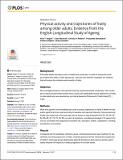Files in this item
Physical activity and trajectories of frailty among older adults : evidence from the English Longitudinal Study of Ageing
Item metadata
| dc.contributor.author | Rogers, Nina T. | |
| dc.contributor.author | Marshall, Alan | |
| dc.contributor.author | Roberts, Chrissy H. | |
| dc.contributor.author | Demakakos, Panayotes | |
| dc.contributor.author | Steptoe, Andrew | |
| dc.contributor.author | Scholes, Shaun | |
| dc.date.accessioned | 2017-02-03T11:30:15Z | |
| dc.date.available | 2017-02-03T11:30:15Z | |
| dc.date.issued | 2017-02-02 | |
| dc.identifier | 249068472 | |
| dc.identifier | b69d00cb-8dbf-487a-ab9a-93ec274173b9 | |
| dc.identifier | 85011332560 | |
| dc.identifier | 000396161200054 | |
| dc.identifier.citation | Rogers , N T , Marshall , A , Roberts , C H , Demakakos , P , Steptoe , A & Scholes , S 2017 , ' Physical activity and trajectories of frailty among older adults : evidence from the English Longitudinal Study of Ageing ' , PLoS One , vol. 12 , no. 2 , e0170878 . https://doi.org/10.1371/journal.pone.0170878 | en |
| dc.identifier.issn | 1932-6203 | |
| dc.identifier.other | RIS: urn:7A33E8C46C14B9DA707609A5E83574A5 | |
| dc.identifier.uri | https://hdl.handle.net/10023/10223 | |
| dc.description | The work was supported by the National Institute on Aging in the United States (grants 2RO1AG7644-01A1 and 2RO1AG017644) and a consortium of UK government departments coordinated by the Office for National Statistics. | en |
| dc.description.abstract | Background: Frail older adults are heavy users of health and social care. In order to reduce the costs associated with frailty in older age groups, safe and cost-effective strategies are required that will reduce the incidence and severity of frailty. Objective: We investigated whether self-reported intensity of physical activity (sedentary, mild, moderate or vigorous) performed at least once a week can significantly reduce trajectories of frailty in older adults who are classified as non-frail at baseline (Rockwood’s Frailty Index [FI] ≤ 0.25). Methods: Multi-level growth curve modelling was used to assess trajectories of frailty in 8649 non-frail adults aged 50 and over and according to baseline self-reported intensity of physical activity. Frailty was measured in five-year age cohorts based on age at baseline (50–54; 55–59; 60–64; 65–69; 70–74; 75–79; 80+) on up to 6 occasions, providing an average of 10 years of follow-up. All models were adjusted for baseline sex, education, wealth, cohabitation, smoking, and alcohol consumption. Results: Compared with the sedentary reference group, mild physical activity was insufficient to significantly slow the progression of frailty, moderate physical activity reduced the progression of frailty in some age groups (particularly ages 65 and above) and vigorous activity significantly reduced the trajectory of frailty progression in all older adults. Conclusion: Healthy non-frail older adults require higher intensities of physical activity for continued improvement in frailty trajectories. | |
| dc.format.extent | 12 | |
| dc.format.extent | 542984 | |
| dc.language.iso | eng | |
| dc.relation.ispartof | PLoS One | en |
| dc.subject | H Social Sciences | en |
| dc.subject | RA0421 Public health. Hygiene. Preventive Medicine | en |
| dc.subject | 3rd-DAS | en |
| dc.subject | SDG 3 - Good Health and Well-being | en |
| dc.subject.lcc | H | en |
| dc.subject.lcc | RA0421 | en |
| dc.title | Physical activity and trajectories of frailty among older adults : evidence from the English Longitudinal Study of Ageing | en |
| dc.type | Journal article | en |
| dc.contributor.institution | University of St Andrews. Geography & Sustainable Development | en |
| dc.identifier.doi | https://doi.org/10.1371/journal.pone.0170878 | |
| dc.description.status | Peer reviewed | en |
This item appears in the following Collection(s)
Items in the St Andrews Research Repository are protected by copyright, with all rights reserved, unless otherwise indicated.

